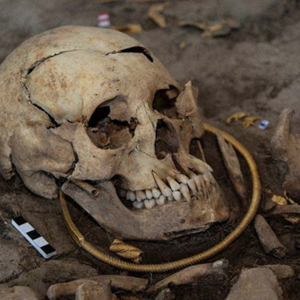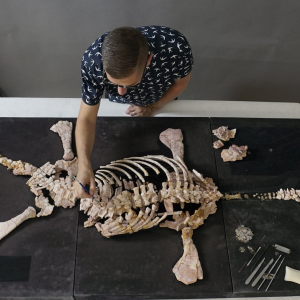Archaeologists in Egypt have unearthed the earliest known “Beer Mega-factory,” an ancient beer factory that was producing mind-altering brews at least 5,000 years ago – on an industrial scale. This adds to a long line of ancient beer-related discoveries which have helped the archaeological community understand more about the history of this ancient beverage.

Ancient Beer Discoveries Across the World
Ergo residue discovered on stone mortars found in Raqefet Cave, northern Israel, were created earlier than 13,000 years ago, suggesting that before agriculture the Natufian civilization had developed the production of beer. Troughs for making beer were discovered at Göbekli Tepe in eastern Turkey, known as the so-called “earliest temple in the world,” dating back to over 11,000 years ago. In Mesopotamia, the oldest evidence of beer production is recorded on a 6,000-year-old Sumerian tablet depicting Sumerian people drinking from a communal bowl through reed straws. While in both Neolithic Europe and in China, as far back as 5,000 years ago, Chinese beer was brewed using barley and other grains.
Now, also dating back 5,000 years, a massive ancient beer factory has been found at the ancient city of Abydos, near the River Nile, about 450 kilometers (280 miles) south of Cairo. But not only was the drink an after work refreshment in ancient Egypt, but for the elites, beer was a key part of the spiritual dynamics of life and death.
Unearthing the Vast Beer Production Zone
Mostafa Waziri, secretary general of the Supreme Council of Antiquities, announced on Saturday that evidence gathered from the ancient beer factory dates it to the region of King Narmer. While Narmer is often credited with having united Egypt at the beginning of the First Dynastic Period (3150 to 2613 BC), “Menes” is considered the first king of ancient Egypt, and the majority of modern Egyptologists identify Narmer as Menes.

Ancient Wari Culture of Peru Prevented Wars with Beer Parties
A Drink Fit for Goddesses: Beer and Mankind in Ancient Mythology
Researchers Brew Biblical Beer Using Yeast From Ancient Pottery
A team of American and Egyptian Egyptologists found “eight enormous production units,” averaging about 20 meters (about 65 ft) long and 2.5 meters (16.4 ft) wide, but there are some over 35 meters (114.8 ft) long and containing more than 80 individual ceramic vats used for the cooking, or mashing, stages of beer production. In the latest entry of the field diary for Abydos Archaeology, the researchers write “and as we’ve yet to reach the full extent of even the longest examples, they will only continue to get bigger.”

The pottery basins contained residue samples that were determined to have had been used to heat a mixture of grain and water to produce beer. Clearly, according to Waziri, the facility was “producing prodigious amounts of quaff in one of ancient Egypt’s major early cities.” According to Abydos Archaeology, “If all eight brewery structures were of comparable size, the overall production capacity of the brewery would approach 50,000 liters (or 100,000 pints) per batch. This represents a truly industrial scale of production, even by modern standards.”
Drinking Your Way to Eternity
From the earliest times of ancient Egypt, Abydos was an extensive assembly of cemeteries and temples dedicated to the ancient Egyptian god of the underworld, Osiris, who was responsible for judging souls in the afterlife. Dr. Matthew Adams of New York University’s Institute of Fine Arts was co-chairman of the archaeological mission. Adams suggests that beer was being produced in Egypt, “not only for simple drinking, but for use in rituals by the elites.” In relation to the 13,000-year-old beer production they explored in Raqefet Cave in Israel, the 1956 team explained that “the ancients desired beer to elevate them spiritually. Just as we do today.”
Adams speculates that the goddess Tjenenyet, governess of women in labor, was perhaps also responsible for the brewing of beer during the Middle Kingdom and start of the New Kingdom. However, Tjenenyet, is generally depicted with a bovine uterus on her head, “not a beer pot,” said Adams. In November last year I wrote an Ancient Origins news piece about the discovery of one of the existing known copies of the Books of Breathing. Professor Foy Scalf, head of the Research Archives at the University of Chicago, published his analysis of the First Book of Breathing in the October edition of the Journal of Near Eastern Studies, in which he showed the dead were expected to continue “breathing, eating and drinking in the afterlife.”

According to the Haaretz article, one fragment of a Book of Breathing, written for the Hor, a Theban priest for Amun-Ra, explicitly mentions: “May your ba-spirit make for you an invocation-offering consisting of bread, “beer,” beef and fowl, and of cool water and incense in the course of [every] day.” Now, in Abydos, an actual beer manufacturing factory brings all of these otherworldly references into high resolution. After-all, ancient Egyptians essentially believed the afterlife comprised all of the great things about this life – food, drinks, homes and pets, but free of illness and debts. Beer, therefore, would probably be on most folks’ lists for their ideal eternity, right above or below wine.





